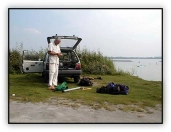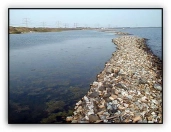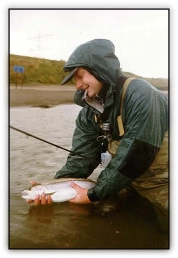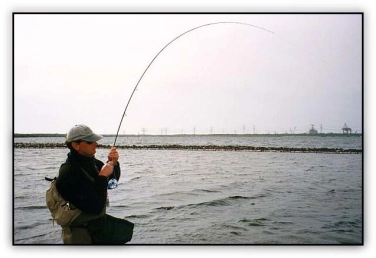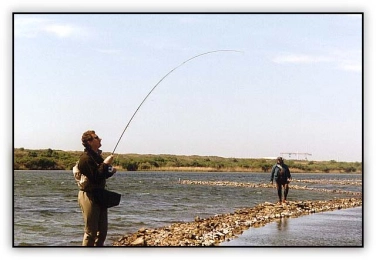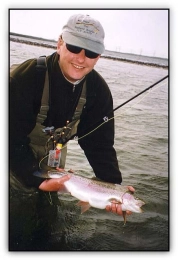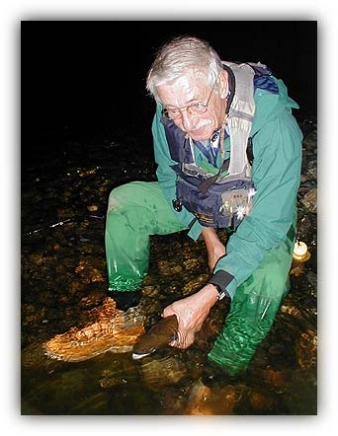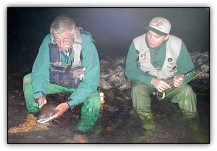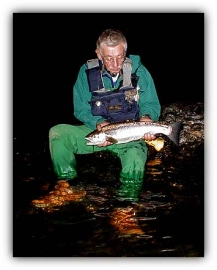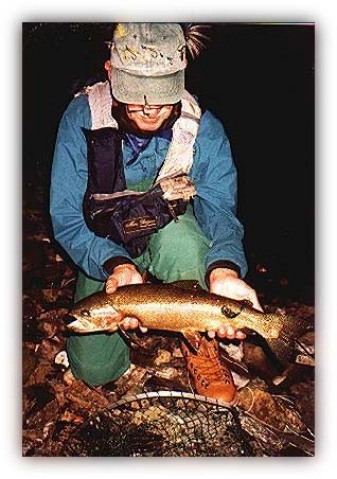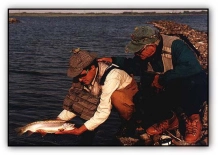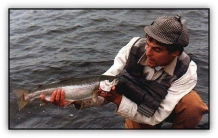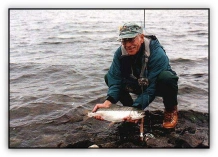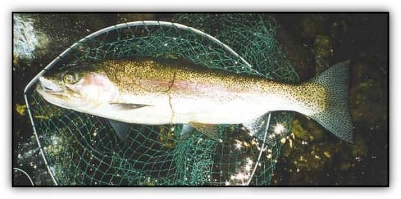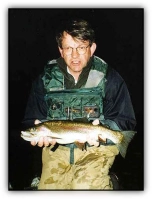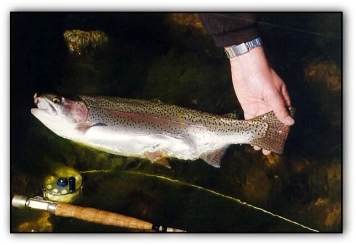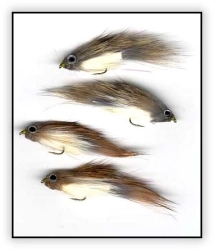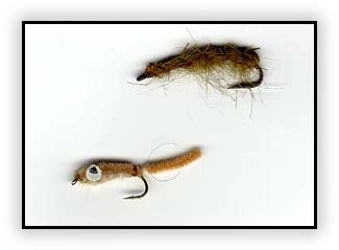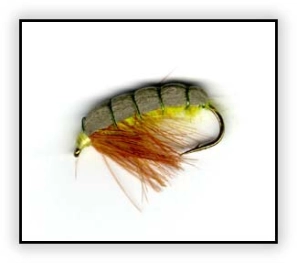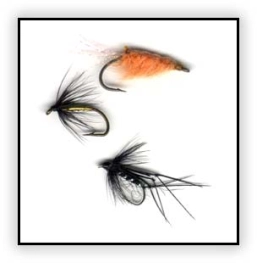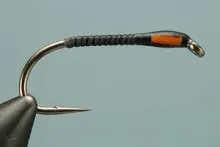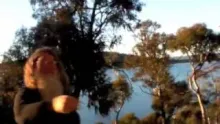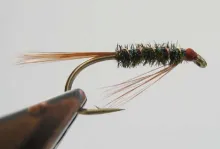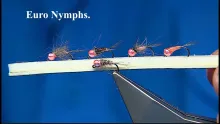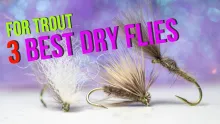A Welshman's story about the little known Dutch steelhead fishing in Lake Oostvoorne. By Paul Slaney.
The road to Oostvoornse Meer cannot be described as a beautiful one, in fact the last 33 kilometers (20.5 miles) of the A16 to the Rotterdam Europoort borders what must be the most industrially developed area of the Netherlands.
Mile after mile of wind generators, petrochemical plants, oil refineries and the infrastructure of the largest working seaport in the World stretches as far as the eye can see. When you realise that there are some 6000 individual ship harbours the scale comes into perspective. It can only be described as colossal.
Industrial bleakness
It was down this road that I travelled one Wednesday afternoon, the industrial bleakness heightened by driving wind and rain. However the atrocious conditions faded into insignificance at the prospect of a few days fishing at this remarkable lake. Memories of an all too brief previous visit and the one tenacious rainbow I caught that day buoyed me along as I turned into the pretty little town of Oostvoorne in search of somewhere to stay.
A quick chat with the landlord of the Cafe Central and I found myself a comfortable room complete with breakfast and a packed lunch for 55 guilders per night. Damn good value in anybody's book. A quick note here for future reference; Wednesday isn't the best day to arrive in Oostvoorne if your taste is fishing. The flyshop is shut all day. So with no licence I went back to the Cafe Central to enjoy some good Dutch food, beer and excellent brandy.
Rovers' conqueror
Thursday morning dawned sunny with a light breeze, ideal I thought, as I drove down to the Northern shore of the Meer, turned left at the diving club, headed up a muddy track through that swampy area there (some of you reading this will know it!) and got firmly stuck in thick, black, smelly, insect infected mud!
Whoever it was that said Land Rovers could take you anywhere in the World has obviously not tried to tackle Oostvoornse Meer in one! But anyway I digress. Suffice to say that a couple of hours later, with a few blisters, wet and muddy clothes and several tow-truck guilders worse off, I was finally threading the line through the rings almost shaking with anticipation.
550 windy acres
Perhaps here is a good point to talk about the lake in general? At roughly 550 acres it's quite a sizeable expanse of water. On a map it resembles a kidney shape with one end larger than the other. Just a stones' throw from the North Sea, the weather there can be demanding on the fisherman to say the least, with wind being the main problem. Stiff, constant, coastal winds that can change direction several times in a day. And when it rains it's possible to spot Noah in that big boat of his float past.
Its Northern and Eastern shores consist of high sandy, grass covered dunes, the swampy area I talked about being in the North East corner. This side of the lake marred by the giant unloading cranes and overhead power cables visible at the Europort just across the way. To the South and East, lower dunes, this time clothed in thick, thorny bushes provide a more pleasing aspect.
Crystal clear water
The shore is generally sandy and easily accessible with the exception of the western end where the bushes meet the water, making this area a fairly long wade to reach. But worth the effort. So open and exposed to the elements would be the concise description.
The Meer, at one time was open to the sea. Indeed, in the 16th century was used as a seaport. In more recent times however it was dammed off to prevent erosion to the surrounding landscape and as such it remains saline. Depending on whom you talk to on the bankside, anywhere from 20%-60% saline. The water is crystal clear, with a sandy bottom. The darker patches you see are weedbeds, of which I counted three types, none of which I'm familiar with.
The lake is a veritable bouillon for the trouty gourmets who inhabit it. With shrimp, gudgoen, saltwater cressbugs (hoglice I think) sticklebacks and herring fry. The surrounding grassland and bushes provide terrestrial manna from heaven. With bibio, cranefly and god knows what else. Whilst extracting my truck from the swamp I saw at least three types of midges, caddis, tadpoles and frogs. The lakeshore is littered with shellfish, two types of small clam and cockles were the ones I could see, though I found no evidence that the fish feed on them.
And the fish...
What about the fish I hear you ask? Well, they are all rainbow trout, stocked once a year at 10 inches in length. With all the food available to them they grow on at a phenomenal rate, again, the bankside telegraph is a little confusing but we are talking somewhere between 20 and 35 millimeters (3/4 - 1 1/4") PER MONTH! It all adds up to a population of the fattest, happiest fish I've ever come across.
One final feature that adds to the interest I have in this lake. And that's the stone walls. For perhaps 90% of the lake circumference, at a distance that varies from just a few metres to over a 100 metres (300') from the shore are a series of stone walls, built to a height that exceeds the water depth by about a foot. The walls vary in length and are separated by breaks, through which the wind driven currents swirl and create fishy looking areas on the inside.
This has the effect of dividing the lake into two separate lagoons, the larger inner lagoon being the main body of the lake with the outer lagoon extending for most of the circumference. For this trip, as I had no access to a boat, pontoon or tube I concentrated on this outer area. Though in some areas you can wade out to the walls and take a cast or two into the deeper water. More on this later.
Step, cast, step
So where was I? Oh yes! Rod threaded up with a Triangle Taper Clear intermediate, short, stout leader and a size 8 bunny fry. I started to make exploratory fan casts into and across the wind along the northern shore in the Welsh tradition, step, cast, step.
Very quickly the line went solid. Weed! I thought. But as Montana friend Jim Shive said to once in a similar situation: "the bottom don't shake its head like that Paul!"
A few powerful lunges and the fish was gone. Even though I'd briefly tasted the power of these fish last September, the savage take and run shocked me. With even more determination I continued to cast for an hour or so but with no result.
A quick regroup for a coffee and sandwich and from my higher elevation on the bank I could see calmer water just inside the walls some 60 meters away. So a tentative wade with the water lapping at the top of my chesties and I was on the wall watching fish rise to black wind bourn flies within an easy cast of my position.
A change to a floating line, longer leader with a size 14 Bristol Hopper in black on the point and a pearl and black spider size 14 on the dropper was all that was needed. 5 fish fell to the hopper and one to the spider in quick succession. The fish were all in the 16-18 inch range, silver bright, fit and acrobatic and led a merry dance on the light leader. I can only assume they were the result of the December stocking and would seem to confirm the growth rate figures quoted earlier. All in all a nice way to re introduce myself to Oostervoornse even though the bigger inhabitants had so far alluded my offerings.
Shortly after this purple patch the weather switched for the second time since my arrival, with the wind gusting enough to remove my hat and the start of a rain storm that put paid to the fishing for the rest of the day.
Club invitation
Back at the Cafe Central and a delicious dinner of baked mussels. Over dinner I had a phone call from Bart van der Schrieck (Dutch Guy in the VFS chatroom) who was intending to join me for an evening session on the lake. With regret I had to inform him of the conditions. But he had a plan B, which was to invite me to visit his fly fishing club in Den Haag (a 30 minute or so drive away) who were meeting that night.
I didn't need asking twice and within a short time we met at a car park near the motorway, a quick introduction to Mrs Dutch Guy who was intrigued to meet this mad Welshman that spent so much time yakking with her husband online, and off to the club.
I enjoyed a fine evening in interesting company, their club house is in the second floor of a converted stable (over 100 years old) indeed it's the oldest flyfishing club in Holland and is a treasure trove of piscatorial delights. The members of the Nederlands Vliegvis Gezelschap (Dutch Flyfishers Guild) are very well travelled and connected in the fishing world with large framed photos of their various exploits adorning the walls, framed collections of flies by some well known international tiers, a library, big tying table, a pool table, a bar, a lounge.
Large Mouth Bass
Wow! I thought I must have died as most certainly I was in heaven! I finally got to meet Bas Verschoor (LMB in the chatroom) and he together with Dutch Guy extended some fine hospitality, which included some tasty Dutch Brandy. It seems I'm now on LMB's email joke list, I'm not sure if that's a good thing or not? BTW, if you are ever in the area pop in on Dutch Guy and get him to show you his scrapbooks of his trips to Yellowstone and Slovenia. Quite something I assure you.
And the contents of Bas' flyboxes? Well, you have to see for yourself, outstanding! Thanks Bart and Bas for a fine evening.
Mirror calm
Friday - 5:30 am found me standing on the same wall as the day before, same rig. The lake was mirror calm and shrouded in a thick fog and bloody cold! Again I had the place to myself (for a few short hours anyway) The surface occasionally broken by a creepy swirl or splash in the murk. But I was to remain fishless till much later in the day.
By 9 am the fog had burned off in the bright sunlight and the wind had picked up again. Stronger than before and again from a different direction.
Time to make a move to the Western end of the lake to move the wind from my face to my left shoulder. I was greeted by 18" high waves and fish moving in the surface again, this time bigger fish. Big enough to leave a flat spot in the water as they turned to feed. Exciting stuff.
It was impossible to control a dry fly drift in these conditions so keeping the floating line and long leader I tied on a bunny fry and plopped it in the water in front of me to see how it swam and get it nice and wet.
Line dance
From right under my feet one of the Oostvoornse giant rainbows appeared, swirled at the fry, missed, came back, swirled again, missed again. I was too busy doing the line dance to do much about it and totally missed any opportunity of hooking the fish which promptly disappeared to the depths. Back to the car for my line tray, which didn't leave my waist for the rest of the trip.
Finally, all sorted out and getting nice cross wind, curve drifts, the bunny swimming well about 10 inches under and a slow figure 8 retrieve keeping things nice and tight and at last a take. A heart stopping, hand wrenching, line burning Oostervoornse take.
Fantastic! The fish took off like a rocket to my left, stayed down deep and certainly didn't want to play ball...
These bigger fish fight down and dirty like a big spotty. The power at their disposal is quite amazing, even at the last their big spade tails are trying to pump the fish back down to the depths and safety. But at last, in waste deep water I got my hands on her, dark olive back, iridescent magenta flanks and a tail the span of my hand from thumb to little finger. 24-26", my estimate would be somewhere between 7 and 8 lbs. in weight. As I released her, she shot me a look of hatred and with a powerful, contemptuous flick of her tail disappeared to safety.
LDR
Over the next hour or so I had two more takes, one nothing more than that, the other resulted in a LDR after a few minutes of spectacular battle. The wind by now was taking its toll on my energy and casting ability so I headed over to the Southern shore to put the wind at my back. Upon arriving I found the area nearest the car park to be quite sheltered and pleasant in the sunshine. A fact obviously noticed by the locals before I did as there were several fishermen lined up along that stretch along with families enjoying the sunshine on the sandy beach there.
The walls here are quite close to the bank certainly within 20-40 (60-120') meters and the water inside relatively deep, up to about 3 meters (9'). So good water an easy cast from the shore. I spent a long time combing the beach in the shallows watching the water life. And was occasionally rewarded by the sight of a marauding rainbow zoom into the shallows and take a gudgeon or shrimp off the bottom by swimming on its side and scooping the unfortunate creature off the lake floor along with a mouthful of sand. I've seen rainbows attack weed beds in this way before but never the bare lakebed. Interesting.
Dutch Scampi
A few experimental casts with the bunny fry but with the lack of a crosswind I felt that it wasn't swimming well enough to convince the fish. So off with the fry and on with a pink shrimp. Size 10, with mono eyes, shell back, mono rib and "root beer" (pinkish orange) feelers.
The whole thing tied ass backwards on a curved longshank hook.
A cast straight out to the wall and a painfully slow figure 8 retrieve did the business after much experimentation. Another 'bow slightly smaller than the last was firmly hooked in the scissors and proceeded to lead me at a run some 50 meters down the bank, with a full flyline and too much backing for my liking outside the tip ring. By the time she came to hand I was in dire need of a sit down and a smoke.
More good food that evening which prompted me to rename the pink shrimp the "Dutch Scampi" and a chat on the phone to Hans and Johann who were joining me the following day.
Hans' famous groaners
Hans arrived early, a little tired from a late night and long early morning drive. But after a quick coffee and trip to the flyshop for the required paperwork seemed to get a second wind. As we headed for the western end of the lake kept me amused with his famous groaners, which on a good day really are bad! (sorry mate!)
On arrival a combination of wind and too many fishermen found us back in the car and headed back to the south to find a comfortable area for right handed casters. Yep, you guessed it the wind had changed again and if anything, was blowing harder than ever.
We both set up with floaters and Dutch Scampies and were quickly fishing the curve presentation again. We concentrated on the break areas between the walls in the current. And in no time at all a nice bow hit my scampi with a jerk. Again the powerful fight right to the last but this time I managed to hold the fish on a shortish line which, if anything, made her fight with even more determination. Again the beautiful markings and paddle tail. Are there no ugly fish in this lake?
Flies with buoyancy
That was it until Johann arrived mid morning. A giant bear of a man, you can spot him coming a mile off. A quick bankside conference and Johann suggested the long wade to the Southwestern corner, where the bushes meet the lake and you can cast at the deep water of the main bowl. Johann fishes here regularly and neither Hans nor I could think of a reason to question his advice.
The three of us spread out along one of the walls. I watched with interest as Johann set up with a clear intermediate, one of his little gudgeon patterns and sent a mighty cast out into the deep water, let it sink right to the bottom and start a slow retrieve.
A couple of casts later, a shout and he was into a fish. Deftly played, photographed and released, an expert at these Oostvoornse fish, having fished there on a regular basis for some years. As you can imagine I changed back to the intermediate in record time and was into Johann fly box like a ferret!
His boxes revealed some interesting patterns tied specifically for Oostervoornse, mainly based around small fry patterns and shrimp. Nearly all included some sort of buoyancy in the dressing to help keep them out of the weed. All simply tied and straightforward. Excellent stuff!
Almost asleep
Hans by now was almost asleep on his feet and decided to go and get some shuteye in the bushes. I think he had the right idea because a fishless period with much water flogging followed with wind knots and tangles on the part of Johann and I.
'Bout the only thing caught was a bit of sunburn with the pair of us resembling panda bears in negative by the end of the day. The shape of our sunglasses clearly visible, causing much amusement later at the Cafe Central.
The boredom was shattered when an experimental change back to a floating line and a brown bunny fry brought a shocking take first cast. The fish fought with every ounce of strength and with very little strength left myself and a straining rod and leader I managed to bring it to hand in time for Hans to switch into photograph mode and get a couple of snaps.
Canny fish
On the way back to the car for some food we were all three defeated by one particularly canny fish. Makes me feel better if I think of it in those terms. It was patrolling a circular route, which took it past our position within 15 feet. Both Hans and I caught our backcasts in the bushes as our excitement got the better of us. Johann who kept his head, couldn't get it to take after we'd scared the daylights out of it.
After lunch, one more missed take, one LDR that came to a dry ant and at the last knockings a final fish, the best of the day at well over 20". Again to the Dutch Scampi.
The bar of the Cafe Central was the scene of the post fishing wash up meeting. Some food, drinks and farewells to the guys both of whom it was great to see and fish with again. Really enjoyed the day guys.
Thanks!
Nothing under 50 centimeters
BTW. Johann showed us his collection of photos taken at the lake, all nice fish. And get this, a Johann quote. "I don't bother photographing fish under 50 centimeters (20") these days". Lucky bugger eh?
The final morning proved sunny and almost calm by Oostervoornse standards, just a stiff breeze from the west.
I met up with Peter Vroegindeweij (Tenthumbs in the chat room) who had driven down to fish from Den Haag that morning. This is dedication for you as it was mothers day in Holland and he was under severe threats to be back in time for lunch. Try as I might I couldn't connect on that final morning whilst Peter calmly and skilfully extracted two fine fish. One of them the biggest of the season for him. His approach was different again, though still using a floating shrimp imitation he fished it on a HiDi sink tip of his own making. Well done Peter!
That's about it, with the 8 hour drive home to Wales looming in my mind it was time to say goodbye to Oostervoornse Meer and the wonderful fish there.
And to Johann, Hans, Rob DeVoer, Peter, Wilford, Herman, Bart, Bas, Willem and all the Dutch fishermen I spoke to at the club and on the bank, who to a man, went out of their way to help make my trip one of the most memorable ever... Thanks guys! Your company was the finest, your hospitality generous to the extreme. I'm grateful for every word of advice and every pattern I stole from your boxes. I only hope I can return some of that hospitality to you one fine day soon.
Tackle used and a couple of points
| Rod: | 9' rated for a number 7 |
| Lines: | A Lee Wulff Triangle Taper 7/8 clear intermediate and a Cortland floating Lazerline WF7 |
| Leaders: | 10 -16' with 5x (dry fly) 3x (wet fly) tippets |
| Flies: | See below |
| I would have been more comfortable fishing my clear sink tip line using the cross wind drift method as I feel the fly would have swam better (ie a little deeper) in the windy conditions. Most of the takes came early on in the retrieve when the fly was at its deepest. Unfortunately I forgot to bring it.The line tray was a godsend. To protect the line from damage on the stony walls, to help control the coils in the wind and help manage the intermediate line whilst deep wading. | |
Dressings for the flies as follows
Point and dropper
1. Bunny Fry (my own pattern)
Hook: standard shank wet fly 4-12
Tail: Zonker strip the same length as the hook shank
Body: Tufts of rabbit fur tied along the length of the shank. Light coloured fur below, darker above.
Head: Strip of rabbit fur, spun in a dubbing loop, wrapped forward and roughly trimmed to shape.
Eyes: stick on epoxy type
The whole head is then soaked in superglue and when dry trimmed smooth with a craft knife.
2. Dutch Scampi (my own pattern)
Hook: any curved longshank hook 10-12
Feelers: Root beer crystal flash.
Shell back: Clear Scudback or similar material.
Eyes: Melted mono. I use 15lb brown maxima.
Rib: clear mono
Underbody: Piece of ethafoam, tied in front and rear. Body: synthetic dubbing in a pale orange pink colour. Well picked out under the hook shank.
3. Pearl Spider (my variation on the theme)
Hook: heavyweight wet fly 12-14
Body: Stretched pearl mylar tinsel over a base of black thread.
Rib: Silver wire or mono.
Hackle: two turns of black hen hackle.
4: Bristol Hopper (my variation on the theme)
Hook: Drennan emerger 10-16
Body: black seal fur
Rib: Medium pearl mylar tinsel, stretched to half its original width
Legs: 6 cock pheasant tail fibers, knotted once. Tied in a bunch under the hook shank.
Hackle: Black cock hackle. 3 or 4 turns.
- Log in to post comments


